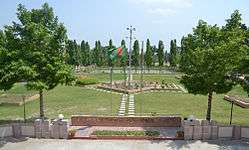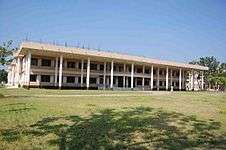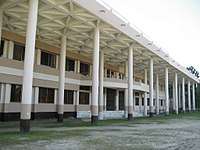Khulna University of Engineering & Technology
|
খুলনা প্রকৌশল ও প্রযুক্তি বিশ্ববিদ্যালয় | |
 | |
Former names |
Khulna Engineering College (1967-1986)[1] Bangladesh Institute of Technology (BIT), Khulna (1986-2003)[1] |
|---|---|
| Motto | প্রভু আমায় জ্ঞান দাও। |
Motto in English | Oh Lord! Bestow me with Knowledge |
| Type | Public, Coeducational, engineering Technological |
| Established | 1967[2] |
| Endowment | $8 million (2016)[3] |
| Chancellor | President of Bangladesh |
| Vice-Chancellor | Quazi Sazzad Hossain[4] |
| Dean |
Quazi Hamidul Bari[4] Md. Abdur Rafiq[4] Mihir Ranjan Haldar[4] |
Academic staff | 320[1] |
Administrative staff | 132 |
| Students | 5934 |
| Undergraduates | 4834 |
| Postgraduates | 1016 |
| 84 | |
| Address | Teligati,PhulBari Gate, Khulna 9203, Khulna, Bangladesh |
| Campus | Suburban, 101 acres (0.41 km²)[1] |
| Website |
kuet |
Khulna University of Engineering & Technology (Bengali: খুলনা প্রকৌশল ও প্রযুক্তি বিশ্ববিদ্যালয়, pronounced [kʰulna prokouʃɔl o prodʒukti biʃːobiddalɔe̯]) commonly known as KUET ([kue̯ʈ]; Bengali: কুয়েট), formerly BIT, Khulna, is a public engineering university of Bangladesh emphasizing education and research on engineering and technology. This is a renowned university for the study of engineering in Khulna, Bangladesh.
History


Khulna University of Engineering & Technology (KUET), which started functioning from September 2003, is one of the five public engineering universities of Bangladesh in higher education, research and development in engineering and technology. This university was established as Khulna Engineering College in 1974; the college was later converted to a degree-awarding autonomous institution called Bangladesh Institute of Technology (BIT), Khulna in July 1986 through a government ordinance (No. XXI, 1986).
The institute was upgraded to university and renamed as Khulna University of Engineering and Technology in September 2003 under the Khulna University of Engineering and Technology Act, 2003. KUET is financed by the government through the University Grants Commission. The university is an autonomous statutory organization of the Government of Bangladesh. There are statutory bodies like Syndicate, Academic Council, Finance Committee, Planning and Development Committee, Committee for Advance Studies and Research, Academic Committees, etc. for policy- and decision-making on aspects of the university under the framework of the Act.
Academics
Academic structure
The academic division of KUET is organized in 20 departments under three faculties.[5] Fourteen departments offer undergraduate courses. Among them Department of Industrial Engineering and Management ( IEM ) provides Industrial and Production Engineering (IPE) degree to the undergraduate students.
- Faculty of Civil Engineering
- Department of Civil Engineering ( CE )
- Department of Urban and Regional Planning ( URP )
- Department of Building Engineering & Construction Management ( BECM )
- Department of Architecture (ARCH)
- Department of Mathematics ( MATH )
- Department of Chemistry ( CH )
- Department of Physics ( PH )
- Department of Humanities ( HUM )
- Faculty of Electrical and Electronic Engineering
- Department of Electrical & Electronic Engineering ( EEE )
- Department of Computer Science & Engineering ( CSE )
- Department of Electronics and Communication Engineering ( ECE )
- Department of Biomedical Engineering ( BME )
- Department of Material Science and Engineering (MSE)
- Faculty of Mechanical Engineering
- Department of Mechanical Engineering ( ME )
- Department of Industrial Engineering and Management ( IEM )
- Department of Leather Engineering ( LE )
- Department of Textile Engineering ( TE )
- Department of Energy Science and Engineering ( ESE )
- Department of Chemical Engineering ( Chemical )
- Department of Mechatronics Engineering ( Mechat )
Institutes
There are three institutes at KUET for advanced research:
- Institute of Information and Communication Technology (IICT, KUET).
- Institute of Disaster Management (IDM, KUET).
- Institute of Environment and Power Technology (EPT, KUET).
KUET journals and research bulletins
- Journal of Engineering Science
Admissions
The admission process in KUET is highly competitive. Each year it opens about 1005 seats for undergraduate programs. About 10,000 applicants are invited to appear on an admission test. These preliminary filtration is done based on H.S.C. grade points in physics, chemistry, mathematics and English. The admission test is standardized to evaluate student ability to understand concepts of physics, chemistry, mathematics and English language. Admission is offered to successful applicants on a merit basis, based on their scores in the admission test.
Students are admitted to a specific undergraduate academic program specializing any of the 14 engineering tracks (e.g., CSE, EEE, ME, ECE, CE, IPE, BECM, TE, LE, URP, BME, Arch, ESE, MSE). Students may not change their track (major) once a few weeks of classes are passed.
Admission is open to mainly to Bangladeshi nationals. There are 5 reserved seats for "small ethnic group" students who have to undergo the same admission process. A few seats are also open to international students. The international admission process is separate from local admissions.
Campus
|
Khulna University of Engineering & Technology (KUET) is at Fulbarigate, the northwest part of Khulna City (the third largest south-western divisional city in Bangladesh). The campus is about 15 kilometers from the zero point of Khulna City, which is well-connected to the major city centers by open and wide roads. It is at about 12 km from the Inter-District Bus Terminal and approximately 14 km from the Khulna Railway Station.
The KUET campus covers 101 acres. It is divided into four functional zones: residential zone for students; residential zone for faculty and staff; academic zone for academic buildings and workshops; and cultural-cum-social and recreational zone for students. Being square in shape, the third zone is midway between the two residential zones to reduce walking distances.
The main academic building accommodates the teaching and research facilities. Each department is a separate entity with a courtyard around, and all the departments constitute an integrated complex. Heavy engineering laboratories are on the ground floor or other separate workshops. Light laboratories, classrooms and project rooms are on the upper floors. Separate offices for every member of the teaching staffs are next to his/her laboratory.
Library
KUET central library runs in two sections: the General Library and the Reference Library. The General Library provides in-house reading and short-time borrowing of books and other reference material. The Reference Library provides in-place reading.
All students and faculty can enjoy these facilities for more than 10 hours per working day. Audio-visual systems are available. The General Library system has 50,635 books, journals and periodicals. A library automation project to modernize and to improve administrative control over the collection of books, journals, proceedings, theses, etc. has recently been completed under Higher Education Quality Enhancement Project.[6] Moreover, the library is enriched every year by collecting recent books and journals.
Besides the general library system, each academic department maintains a rent-based library from which students can borrow textbooks at a nominal rate for the semester. Recently, KUET library has entered into full automation system.
Medical center
The on-campus, two-storied KUET Medical Center provides primary and basic health care facilities to its students free of charges. Two full-time MBBS doctors and other staff provide the care. For specialized consultation on complicated cases, medical center refers the patients to specialists through ambulance.
Central computer center
The central computer center (CCC) of KUET was established in 1988 under the supervision of the department of Electrical and Electronic Engineering with six IBM desktop computers donated by BEXIMCO. To provide fully integrated set of information support to the teaching, research and administrative functions, in 2006 it became us on independent center of KUET in a newly decorated building under the supervision of a nominated chairman from the university.
The CCC has served over the years as the hub for computer-related services in the campus with the commissioning of the university–wide network.
It has strong IT infrastructure with around 256 Mbit/s broadband line from BTCL and BdREN with 1 Mbit/s from other ISP as backup for Internet facility, routers for routing, a firewall for internet security, five high configuration server as mails server, proxy server, database server, seven midlevel configuration of workstations for other servers and backup server, a core switch, several manageable and unmanageable switches for intranet connectivity. It is planned to increase the bandwidth and to expand and renovate the optical backbone network including student halls of residence and teacher residential area secure access of the academic and research materials very soon.
Recently KUET has started a WiFi network in its Director of Student Welfare (DSW) and CCC arena for students and at the departments of Electrical & Electronic Engineering (EEE) and Electronics, Computer Science and Engineering (CSE), Communication Engineering (ECE) for teachers.
Student life
Halls of residence
There are seven residential halls (one female, six male). The administrative heads of a hall are its provost and assistant provosts. Usually the halls have a single provost and one or more assistant provost(s).
The residential halls provide facilities for the students, for example, hall library, prayer room, TV and recreational room including daily newspapers and magazines etc. Generally four students live in a room except the two-seat rooms in Amar Ekushey Hall arranged for graduate students. These halls have dining rooms (Amar Ekushey Hall has two dining rooms) where monthly prepaid lunch and dinner are offered to the students.
- Bangabandhu Sheikh Mujibur Rahman Hall(named after founding leader of Bangladesh , Sheikh Mujibur Rahman)
- Amar Ekushey Hall(named in memory of martyrs of the Language Movement )
- Fazlul Haque Hall(named after the 1st Prime Minister of Bengal- Sher-e-Bangla A. K. Fazlul Huq)
- Lalan Shah Hall(named after the Lalon Fokir, Lalon)
- Khan Jahan Ali Hall(named after Muslim Sufi Saint, Khan Jahan Ali)
- Dr. M A Rashid Hall(named after M. A. Rashid, the first vice-chancellor of BUET)
- Begum Rokeya Hall(named after Begum Rokeya Social activist, writer, Muslim feminist)
Sports facilities
KUET has a large playground at the eastern periphery of main academic campus. It is used as venue of annual athletics competition of the university as well as cricket, football competitions. Students can access the facility all year round.KUET has tennis court in the main academic area. It also has a gymnasium near halls of residence where students can do gymnastics.
See also
References
- 1 2 3 4 "About KUET". Khulna University of Engineering & Technology. Archived from the original on 6 August 2011. Retrieved 1 January 2017.
- ↑ "History". Khulna University of Engineering & Technology.
- ↑ As of July 02, 2016. "KUET sanctions Tk 60 cr budget". The Daily Observer. 2 July 2016.
- 1 2 3 4 "Administration". Khulna University of Engineering & Technology.
- ↑ "Departments of KUET". Khulna University of Engineering & Technology. Archived from the original on 8 August 2011. Retrieved 3 September 2016.
- ↑ (HEQEP)
External links
| Wikimedia Commons has media related to Khulna University of Engineering & Technology. |
Coordinates: 22°53′59″N 89°30′09″E / 22.8996895°N 89.5026112°E



